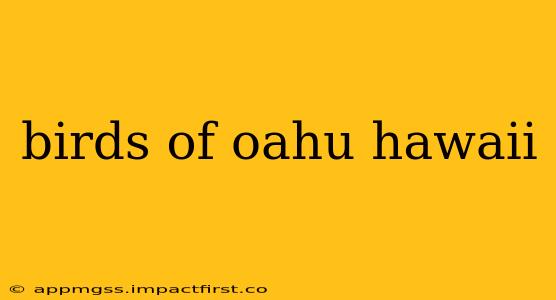Oahu, the "Gathering Place," is more than just beautiful beaches and vibrant city life; it's a haven for a diverse array of bird species, many of which are found nowhere else on Earth. From the bright plumage of the Apapane to the haunting call of the 'Io, Oahu's avian inhabitants offer a captivating glimpse into Hawaii's unique natural heritage. This guide explores the remarkable birds of Oahu, providing insights into their habitats, behaviors, and conservation status.
What are some common birds found on Oahu?
Oahu boasts a fascinating mix of native and introduced bird species. Among the most common native birds you'll encounter are the Apapane ( Himatione sanguinea), known for its vibrant crimson plumage, and the 'I'iwi (Drepanis coccinea), with its striking scarlet body and long, curved bill. These nectar-feeding birds are crucial pollinators in the Hawaiian ecosystem. You'll also find the 'Apapane, a small, honeycreeper with a bright red body, often flitting among the blossoms. Other common native species include the 'Amakihi (Chlorodrepanis virens), a small, olive-green bird with a yellowish underbelly, and the 'O'ahu 'Elepaio (Chasiempis ibidis), a flycatcher with a distinctive black and white plumage.
Introduced species are also prevalent, including the House Finch (Haemorhous mexicanus), the Japanese White-eye (Zosterops japonicus), and the Common Myna (Acridotheres tristis). While these birds have adapted successfully to the island environment, their presence can sometimes impact native populations.
What are some of the rare birds of Oahu?
Unfortunately, many of Oahu's native birds are considered rare or endangered due to habitat loss, introduced predators (like rats and cats), and disease. The 'Akiapola'au (Hemignathus munroi), a unique honeycreeper with a specialized bill for foraging, is a prime example of a critically endangered species. Similarly, the 'Alalā (Corvus hawaiiensis), also known as the Hawaiian Crow, is extinct in the wild but is undergoing a dedicated recovery program. While you might not see these rare birds on a casual stroll, knowing about their plight emphasizes the importance of conservation efforts.
Where are the best places to birdwatch on Oahu?
Oahu offers numerous fantastic locations for birdwatching, each with its unique avian inhabitants. The Ho'omaluhia Botanical Garden provides a diverse range of habitats and attracts a wide variety of species. The Lyon Arboretum is another excellent spot, featuring lush rainforest and diverse birdlife. Coastal areas, such as the Makapu'u Point Lighthouse Trail, offer opportunities to spot seabirds. Finally, exploring the forests and valleys of the Ko'olau and Wai'anae mountain ranges can reveal more elusive species. Remember to always respect the natural environment and maintain a safe distance from the birds.
Are there any endangered birds on Oahu? What is being done to protect them?
Yes, several birds on Oahu are critically endangered. The primary threats are habitat loss from development, the introduction of invasive species (predators and diseases), and climate change. Conservation efforts involve habitat restoration, predator control programs (such as rat eradication), and captive breeding programs for endangered species like the 'Alalā. Organizations like the U.S. Fish and Wildlife Service and the Oahu Army Natural Resources Program play crucial roles in protecting these birds and their habitats. Public awareness and responsible tourism practices are also essential for long-term conservation success.
What is the best time of year to go birdwatching on Oahu?
Oahu offers excellent birdwatching opportunities year-round. However, the best time to visit is often during the cooler, drier months (from November to April). During this time, migration patterns might bring in additional bird species, and the weather conditions are generally more favorable for outdoor activities.
What are some tips for birdwatching on Oahu?
- Bring binoculars: Essential for getting a closer look at these fascinating creatures.
- Use a field guide: Helps you identify the different species you encounter.
- Go early in the morning or late in the afternoon: Birds are often more active during these times.
- Be quiet and respectful: Avoid disturbing the birds or their habitats.
- Dress appropriately: Comfortable clothing and footwear are important, especially if you plan on hiking.
- Bring water and sunscreen: Protect yourself from the elements.
- Respect private property: Stick to designated trails and public areas.
By understanding the diverse avian life of Oahu and supporting conservation initiatives, we can all contribute to preserving this precious natural heritage for generations to come. Happy birdwatching!
